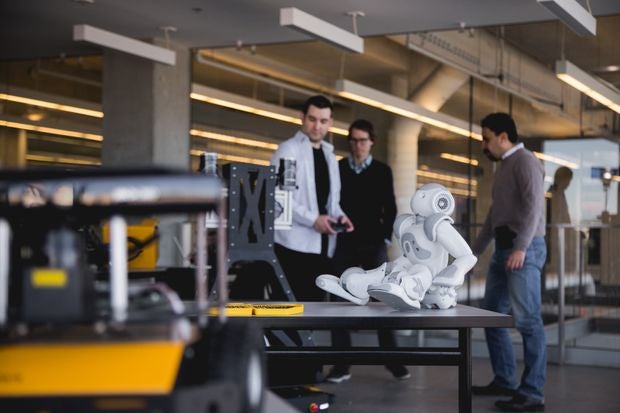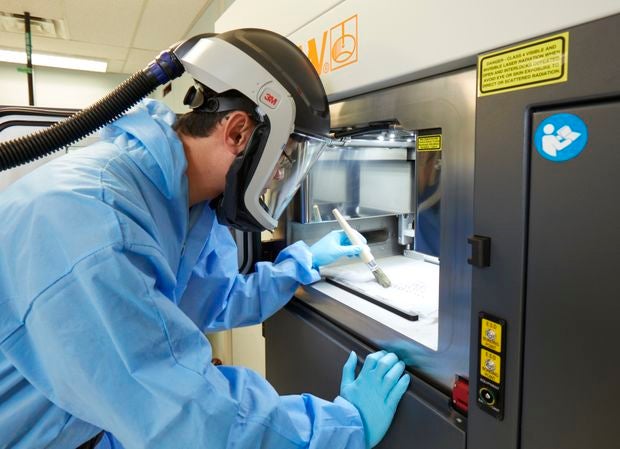The Globe and Mail published an article on the RoboHub along with the other facilities in the new E7 building. Visit their website for the original article.
If robotics development is anything like driving a car, the University of Waterloo is about to upgrade to a brand-new Ferrari from an old jalopy.
This fall, students and faculty will be able to access the RoboHub – a purpose-built test facility for a variety of robots, from humanoids and wheeled vehicles to flying drones.
The 1,000-cubic-metre chamber will span two floors in the centre of the university's new, $88-million E7 engineering building and feature a magnetic levitation pad and switchable frosted glass around its perimeter. Users will be able to work in private or make their experiments visible to onlookers throughout the building.
The move will be a step up from the existing testing facility – literally an old garage elsewhere on campus that is currently jury-rigged with cameras and sensors haphazardly sitting on desks, chairs and other furniture.
The RoboHub will be a cutting-edge lab enabling researchers and students to test their creations in real-world situations, rather than only in virtual simulations.
The University of Waterloo's RoboHub, a testing facility for robots, will allow researchers and students to test their creations in real-world situations.

"It's a terrarium for robots," says Brandon DeHart, RoboHub manager and sessional engineering instructor, of the new space.
"We're going to be bringing people together and developing a common testbed."
The RoboHub is the main attraction of E7, a seven-floor, 242,000-square-foot building that broke ground in 2015. The federal government chipped in $32.6-million, with the university contributing $10-million. The remainder of the $88-million is coming from private donors.
University officials expect the space will allow annual engineering enrolment to increase by about 2,100 students from 1,900, especially in the mechatronic and biomedical programs.
With nearly 8,000 undergraduate and 2,000 graduate students enrolled in 15 programs, the University of Waterloo counts engineering as one of its major strengths. It regularly produces graduates who go on to launch startups or work for major technology companies, including Google and Microsoft.
Despite that, officials don't believe students are properly prepared for what is known as the fourth industrial revolution, or the fusion of physical and digital technologies.
"The generation we have is fast, but they are conceptually missing what they are looking at," says Pearl Sullivan, dean of engineering. "The lack of context in our current curriculum, teaching pedagogy and engineering all over the world is scary because context allows you to have judgment. Engineering is about judgment."
E7 is thus geared toward encouraging physical experimentation and collaboration alongside theoretical learning.
The Ideas Centre, on the building's first floor, can accommodate up to 230 students, who will be encouraged to work together on projects. The space has both a sand and water pit for testing purposes. Electrical outlets and exhaust pipes are attached to the ceiling, allowing for reconfigurability.
A second floor, equipped with large TV screens and audio-video editing suites, will allow for tinkering with the digital side of projects.
"It can be used for anything," says Sanjeev Bedi, a professor in the mechanical and mechatronics department. "That's the whole point."
E7 will also allow for the expansion of additive manufacturing, also known as 3-D printing. Three new labs will more than double the department's existing space, creating the largest additive manufacturing academic research facility in the country and fifth largest in the world, according to the university.
Students will be able to experiment in printing with new materials, including ceramics and conductive polymers, for biomedical and wearable technology applications.
The department expects to grow quickly from a current head count of 59. "This is going to be a good cluster of scientists and students in one place," says Mihaela Vlasea, an assistant mechanical and mechatronics engineering professor.
The University of Waterloo's Multi-Scale Additive Manufacturing Lab will allow students to experiment with 3-D printing with new materials, including for biomedical applications.

Outside donors say the engineering program's pedigree is what attracted them to help fund the new building. Kris Shah, whose Mississauga, Ont.-based company Baylis Medical Co. Inc. donated $350,000, likes how the university stresses real-world experience through co-operative work placements.
“All of Canada’s engineering schools are very good, but Waterloo is doing the right type of work in educating engineers to take a broader view than just purely academic,” says Mr. Shah, who graduated from the university’s electrical engineering program in 1986.
The federal government allotted money from the $2-billion Post-Secondary Institutions Strategic Investment Fund launched in 2016.
"They are creating and educating engineers who are world-class," says Bardish Chagger, MP for Waterloo and leader of the government in the House of Commons. "It's not just the region that benefits, it's the entire country."
Ultimately, officials hope the university's holistic approach to education – where digital skills are combined with practical application – will help make graduates more competitive as the fourth industrial revolution takes hold.
“The new world order requires a totally different framework of education and knowledge; that’s how we’re actually going to make it as a country,” Dr. Sullivan says. “We can’t just do depth, we need breadth – but more importantly, we need integration.”